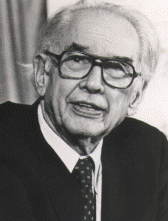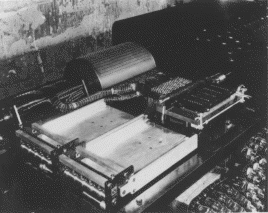Stephenson:Neal:Cryptonomicon:10:Atanasoff and Berry's computing machine (Alan Sinder)
From the Quicksilver Metaweb.
This is the Cryptonomicon page for the ABC - Atanasoff Berry Computer
Stephensonia
Like many, Lawrence Waterhouse misunderstands the super vision powers of Superman specifically his X-Ray Vision. Objects as dense or denser than lead can impede this ability. Contrary to some beliefs, lead objects are not invisible to Superman's X-Ray Vision; they simply appear opaque to him. Nor do his eyes actually emit X-rays.
Atanasoff Berry Computer
When not marching back and forth on the flood plain of the Skunk River making loud dinging noises, Lawrence was majoring in mechanical engineering. He ended up doing poorly in this area because he had fallen in with a Bulgarian professor named John Vincent Atanasoff and his graduate student, Clifford Berry, who were building a machine that was intended to automate the solution of some especially tedious differential equations.
The basic problem for Lawrence was that he was lazy. He had figured out that everything was much simpler if, like Superman with his X-ray vision, you just stared through the cosmetic distractions and saw the underlying mathematical skeleton. Once you found the math in a thing, you knew everything about it, and you could manipulate it to your heart's content with nothing more than a pencil and a napkin. He saw it in the curve of the silver bars on his glockenspiel, saw it in the catenary arch of a bridge and in the capacitor-studded drum of Atanasoff and Berry's computing machine. Actually pounding on the glockenspiel, riveting the bridge together, or trying to figure out why the computing machine wasn't working were not as interesting to him.
It seems likely the early computer didn't sound right to him as a pipe organ did.
Authored entries
- TBA
Wikipedia: Atanasoff Berry Computer
Atanasoff Berry Computer is the name applied, long after the fact, to an experimental machine for solving systems of simultaneous linear equations, developed in 1938-42 at Iowa State University by Dr. John Vincent Atanasoff and Clifford E. Berry.
John Vincent Atanasoff
The Atanasoff-Berry Computer, constructed in the basement of the Physics building at Iowa State University, took over two years to complete. It was first demonstrated in November of 1939. The computer weighed more than seven hundred pounds (320 kg). It contained approximately 1 mile (1.6 km) of wire, 280 dual-triode vacuum tubes, 31 thyratrons, and was about the size of a desk.
Because of the machine's innovative use of electronics for arithmetical calculation, it has been described as the first "electronic digital computer". However, it was a special-purpose, non-programmable "hard wired" machine, which distinguishes it from later, more general machines, such as ENIAC, the Harvard Mark I, EDVAC, the University of Manchester designs, or Turing's post-War designs at NPL and elsewhere.
The machine was, however, the first to implement three ideas that are still part of every modern computer:
- Using binary digits to represent all numbers and data
- Performing all calculations using electronics rather than wheels, rachets, or mechanical switches
- Organizing a system in which computation and memory are separated.
The machine was seen by John Mauchly in 1941, and is alleged to have influenced his later work on ENIAC. Mauchly denied this, but it was the basis for a court decision invalidating the ENIAC patents.
The memory was a pair of drums, each containing 1600 capacitors that rotated on a common shaft once per second. The capacitors on each drum were organized into 32 "bands" of 50 (30 active bands and 2 spares in case a capacitor failed), giving the machine a speed of 30 additions/subtractions per second.
Although the Atanasoff-Berry Computer was an important step up from earlier computing machines, it was not fully automatic. An operator was needed to operate the control switches in order for the computer to function properly. Unlike modern computers, the Atanasoff-Berry Computer was not programmable, however; it was the first computer to have separate sections for the memory and computation. Little did Dr. Atanasoff realize that his computer would change the lifestyle of billions of people across the globe.
